What is Bacterial Transduction?
- Bacterial transduction is a method of horizontal gene transfer mediated by viruses called bacteriophages. Unlike other genetic exchange processes such as transformation or conjugation, transduction does not involve direct contact between bacterial cells. Instead, it relies on the ability of bacteriophages to transfer genetic material from one bacterium to another.
- Bacteriophages infect bacterial cells to replicate. During their assembly within the host, these viruses may mistakenly package fragments of the bacterial DNA into their viral particles instead of their own genetic material. When these phages infect new bacterial cells, the DNA they carry can integrate into the recipient cell’s genome, potentially altering its genetic traits. This accidental transfer of bacterial DNA by phages forms the basis of transduction.
- Transduction was first identified by Zinder and Lederberg in Salmonella and later utilized by Hershey and Chase to confirm that DNA is the molecule of heredity. It is a valuable tool in molecular biology and genetic engineering, where it is used to introduce foreign DNA into a host genome.
- There are two primary forms of transduction: generalized and specialized. In generalized transduction, any bacterial DNA fragment can be transferred, as it depends on random packaging errors by the bacteriophage. In specialized transduction, the DNA transfer is restricted to specific regions of the bacterial genome near the phage’s integration site, as it involves errors during the excision of a prophage from the host chromosome.
- Not all bacteriophages can mediate transduction; only those capable of packaging bacterial DNA, known as transducing phages, participate in the process. Transduction is highly selective because bacteriophages recognize specific receptors on bacterial surfaces, limiting the range of bacteria they can infect.
- An advantage of transduction is that it does not require physical contact between donor and recipient cells, unlike conjugation. Additionally, transduction is resistant to degradation by DNase, an enzyme that breaks down extracellular DNA, which makes it distinct from transformation.
- This process can transfer DNA segments ranging from tens to hundreds of kilobases in size, enabling the study of genetic relationships and the manipulation of bacterial genomes. It plays a critical role in understanding bacterial evolution and gene function.
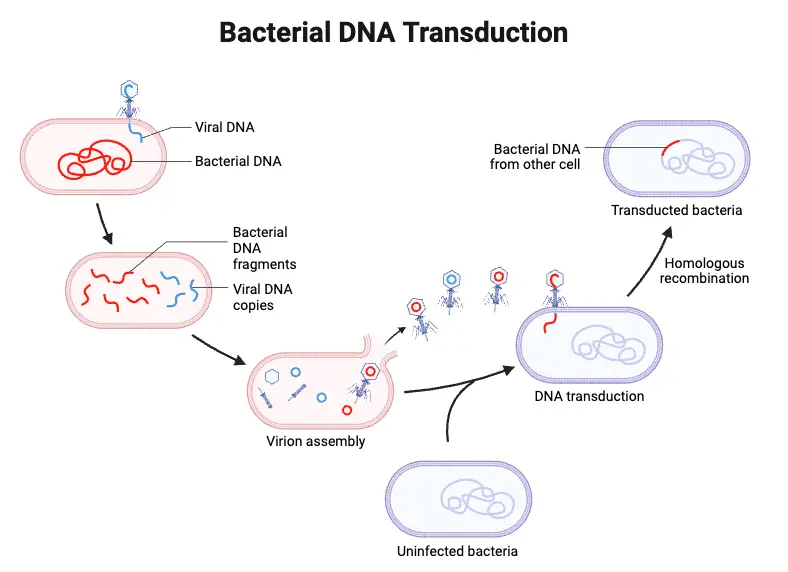
Definition of Bacterial Transduction
Bacterial transduction is a process in which bacteriophages transfer genetic material from one bacterium to another without direct cell-to-cell contact, facilitating gene exchange and recombination.
Principle of Bacterial Transduction
The principle of bacterial transduction is rooted in the infection cycle of bacteriophages, which serve as vectors for transferring genetic material between bacterial cells. This process occurs during either the lytic or lysogenic cycles of bacteriophage replication.
During the lytic cycle, a bacteriophage infects a donor bacterium, hijacking its machinery to produce viral components. Occasionally, fragments of the bacterial DNA are mistakenly packaged into new viral particles. These phages, carrying donor bacterial DNA, are released when the host cell lyses. When these phages infect a new host bacterium, they introduce the donor DNA into the recipient cell’s cytoplasm.
In the lysogenic cycle, the bacteriophage integrates its genome into the bacterial chromosome as a prophage. During excision from the host genome, errors may occur, leading to the incorporation of adjacent bacterial DNA into the phage genome. These phages can then carry the donor DNA into a new host during subsequent infections.
Once inside the recipient bacterium, the transferred DNA may integrate into the host genome through homologous recombination, persist as a plasmid, or initiate replication to produce additional phage progeny. The specificity of the bacteriophage to the bacterial surface receptor determines which cells can be targeted, ensuring precision in the transfer process.
This mechanism highlights the role of bacteriophages as intermediaries in horizontal gene transfer, contributing to genetic variation and adaptation in bacterial populations.
Types of Transduction
Bacterial transduction occurs in two primary forms, each determined by how the bacteriophage packages DNA during its lifecycle. These forms are generalized transduction and specialized transduction, and both play distinct roles in genetic exchange and research applications.
1. Generalized Transduction
- During generalized transduction, bacterial DNA is mistakenly packaged into the phage particle instead of the viral DNA during phage assembly.
- The resulting phage particle, now carrying bacterial DNA, loses its ability to replicate within a host cell because it lacks the complete phage genome.
- When this phage infects another bacterium, it injects the bacterial DNA into the recipient cell’s cytoplasm.
- If the transferred DNA originates from the bacterial chromosome, it may integrate into the recipient genome through homologous recombination, a process requiring the host recombinase protein, recA.
- Most of the transduced DNA, however, remains extrachromosomal and does not stably integrate.
- Applications: Generalized transduction is widely used for gene mapping, introducing mutations, transferring plasmids or transposons, and studying homologous genes across bacterial species.
Steps of Generalized Transduction
Generalized transduction is a process by which bacteriophages transfer bacterial DNA from one host cell to another. This mechanism allows for the horizontal gene transfer of genetic material, contributing to bacterial evolution and diversity. The steps involved in generalized transduction are outlined below:
- Phage Infection of the Donor Cell
A bacteriophage infects the donor bacterial cell, injecting its DNA into the cytoplasm. This initiates the phage replication cycle within the host. - Degradation of Host DNA During Lytic Cycle
As the phage enters its lytic phase, the bacterial chromosome is fragmented into smaller pieces. The phage’s replication machinery facilitates this breakdown. - Packaging of Bacterial DNA into Phage Capsids
During the assembly of new phage particles, some viral capsids mistakenly package fragments of the bacterial chromosome instead of phage DNA. These mispackaged particles are known as transducing phages. - Release of Transducing Phages
The lysis of the donor bacterial cell releases both normal phage particles and transducing phages into the environment. - Infection of a Recipient Bacterium
A transducing phage infects another bacterial cell, transferring the donor bacterial DNA into the recipient’s cytoplasm. This DNA is introduced without causing immediate destruction of the host cell. - Recombination with Recipient DNA
The donor DNA aligns with homologous regions in the recipient’s chromosome. Using host recombinase enzymes like RecA, the donor DNA integrates into the recipient’s genome through homologous recombination, resulting in a stable genetic modification of the recipient cell.
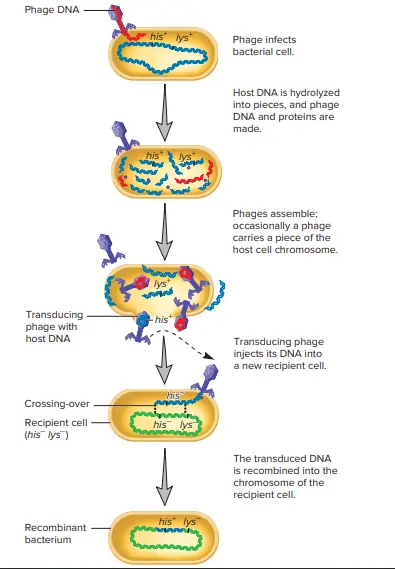
Examples of Generalized Transduction
Generalized transduction relies on bacteriophages to transfer genetic material between bacterial cells. Various phages have been identified as examples of this process, each capable of transferring different bacterial genes. Below are some prominent examples:
- P1 Phage
The P1 phage is a well-known example that can transduce Escherichia coli (E. coli) DNA to a range of Gram-negative bacteria.
This phage is notable for its ability to package random segments of the host’s genome, allowing it to transfer a broad spectrum of genetic material between bacteria. - P22 Phage
P22 is one of the earliest identified phages capable of mediating generalized transduction.
It can transfer genetic material between Salmonella strains, showcasing how phages can facilitate gene transfer across different bacterial species. This is a key example of phage-driven genetic diversity among bacteria. - T4 Phage
The T4 phage transduces genes from Escherichia coli, contributing to the genetic diversity within E. coli populations.
T4’s role in generalized transduction illustrates how bacteriophages drive genetic variation and adaptability in bacterial communities.
Importance of Generalized Transduction
Generalized transduction plays a pivotal role in genetic variation and adaptation in bacterial populations. It involves the transfer of random pieces of DNA from one bacterium to another via bacteriophages. This process is central not only to genetic diversity but also to the spread of critical traits like antibiotic resistance. Below are the key aspects of its significance:
- Genetic Diversity in Bacteria
Generalized transduction contributes to genetic diversity within bacterial populations. By transferring random DNA segments between bacteria, it introduces new genetic material, enhancing the adaptability of bacterial communities. This process helps bacteria adjust to changing environments, which can include pressures like temperature shifts or changes in nutrient availability. - Antibiotic Resistance
One of the most concerning outcomes of generalized transduction is the dissemination of antibiotic resistance. Transducing phages can carry resistance genes from one bacterium to another, spreading these traits across populations. This significantly increases the number of resistant bacteria, especially in pathogens like Staphylococcus aureus and Salmonella, which are involved in serious public health threats. - Phage-Bacteria Cooperation
Generalized transduction is an example of mutualism between phages and their bacterial hosts. Phages ensure their survival by integrating their genetic material into the bacterial genome through lysogeny. In return, bacteria gain new traits, including resistance to environmental stresses. This cooperation boosts the overall fitness of both phages and bacteria in dynamic environments. - Tool for Genetic Engineering
In biotechnology, generalized transduction serves as a crucial tool for genetic manipulation. Scientists exploit the ability of phages to transfer specific genes into bacterial cells. This method is invaluable for creating genetically modified organisms, studying gene function, and advancing research in microbiology and genetic engineering. - Emergence of New Bacterial Strains
The shuffling of genetic material through generalized transduction can lead to the formation of novel bacterial strains. These strains may carry unique combinations of traits, such as enhanced virulence or resistance to treatments. As a result, new bacterial strains may emerge, capable of exploiting new ecological niches or evading host immune defenses, complicating disease management.
2. Specialized Transduction
- Specialized transduction occurs during the lysogenic cycle when the bacteriophage integrates its genome into the bacterial chromosome at specific attachment sites.
- During excision, errors in recombination may result in the removal of adjacent bacterial genes along with the phage genome.
- The resulting phage particle contains both phage DNA and bacterial DNA.
- Upon infection of a new bacterium, the transferred DNA is integrated into the recipient genome along with the phage DNA, initiating another round of lysogeny.
- Unlike generalized transduction, this process is independent of host homologous recombination and does not require recA but relies on the phage’s integrase enzyme for DNA integration.
- Applications: Specialized transduction has been pivotal in identifying genes, studying insertion elements, and understanding the mechanisms of phage DNA integration.
Steps of Specialized Transduction
Specialized transduction occurs when a bacteriophage transfers specific bacterial genes to a new host. Unlike generalized transduction, which involves random pieces of bacterial DNA, specialized transduction transfers only certain genes located near the integration site of the prophage. Below are the key steps in this process:
- Phage Infection of the Donor Bacterium
The bacteriophage infects a donor bacterium and inserts its DNA into the bacterial chromosome, initiating the lysogenic cycle. The viral DNA becomes integrated into the host’s genome. - Imprecise Excision of Phage DNA
When the phage DNA is excised from the bacterial chromosome to enter the lytic cycle, the cut is not always precise. This imprecise excision can result in some bacterial genes being inadvertently included with the phage DNA. - Packaging of Bacterial DNA
The phage particles assemble, and some of them mistakenly package bacterial DNA along with the phage genome. The bacterial DNA integrated near the prophage site is the one that is transferred. - Infection of a New Host
A phage containing bacterial DNA infects a new recipient bacterium. The donor’s DNA, now part of the phage genome, is introduced into the recipient’s chromosome. - Incorporation and Expression of Donor DNA
The recipient bacterium incorporates the donor DNA into its genome during the lysogenic cycle. The recipient then expresses the newly acquired genetic trait, which was transferred by the phage.
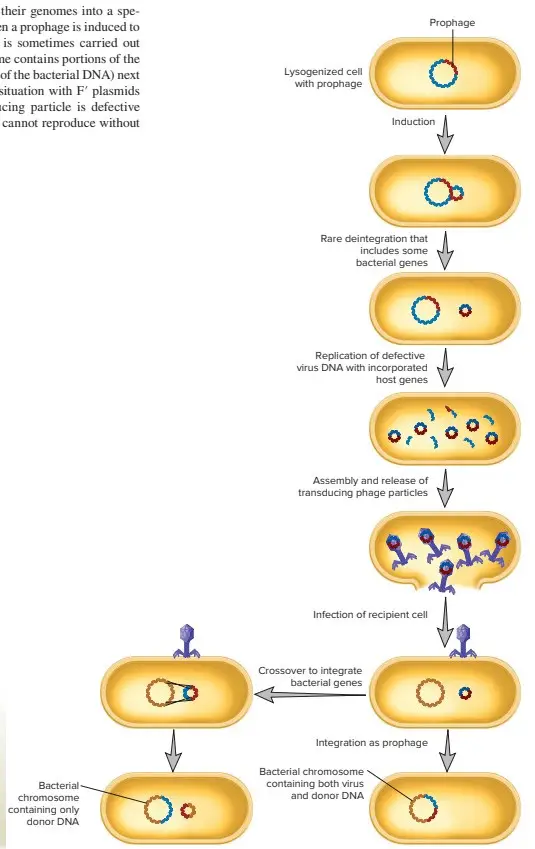
Examples of Specialized Transduction
Specialized transduction occurs when a bacteriophage transfers specific bacterial genes that are located near its integration site. Unlike generalized transduction, this process transfers only a limited set of genes, which can have significant impacts on the recipient bacterium’s traits. Below are key examples of specialized transduction:
- Lambda (λ) Phage
Lambda phage is a classic example of specialized transduction in Escherichia coli.
The λ phage integrates its DNA at a specific site in the bacterial chromosome, typically between genes responsible for galactose and biotin metabolism.
When the phage DNA is excised imprecisely, it can carry adjacent bacterial genes along with the viral DNA. These genes are then packaged into new phage particles, which are transferred to other E. coli cells, introducing new genetic traits. - P1 Phage
While the P1 phage is primarily known for generalized transduction, it can also engage in specialized transduction under certain conditions.
P1 is capable of transducing specific genes from E. coli, especially those genes that are located near the site where the phage DNA integrates into the host’s chromosome.
This ability to transfer specific genetic material further exemplifies how specialized transduction works. - Corynebacterium diphtheriae and Diphtheria Toxin
In Corynebacterium diphtheriae, a bacteriophage transfers the gene encoding diphtheria toxin, a crucial factor for the bacterium’s virulence.
This example highlights how specialized transduction not only facilitates gene transfer but can also enhance the pathogenicity of a bacterium, making it more harmful to the host.
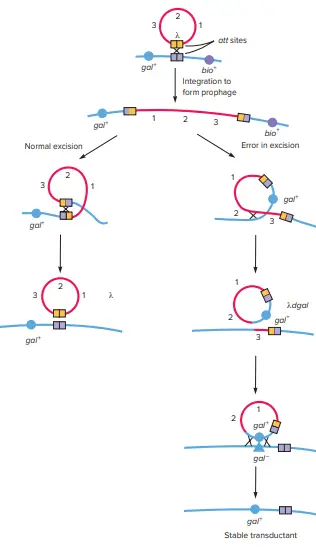
Importance of Specialized Transduction
Specialized transduction is a precise genetic process where phages transfer specific genes from one bacterium to another. This mechanism not only affects bacterial populations but also has practical implications in biotechnology and medicine. Below are the primary contributions of specialized transduction:
- Targeted Gene Transfer
Specialized transduction enables the transfer of genes located near the prophage integration site in the bacterial chromosome. This specific transfer allows bacteria to rapidly acquire beneficial traits, such as virulence factors or enhanced metabolic functions, improving their adaptability to environmental pressures. - Spread of Antibiotic Resistance
Specialized transduction plays a significant role in the spread of antibiotic resistance genes among bacterial populations. Certain phages can carry resistance genes from one bacterium to another, facilitating the persistence of resistant strains, particularly in clinical settings. This is a serious concern in pathogens like Staphylococcus aureus, where antibiotic resistance complicates treatment efforts. - Contributions to Genetic Diversity and Evolution
By enabling the exchange of genetic material, specialized transduction contributes to the genetic diversity of bacterial populations. This diversity is a key factor in microbial evolution, helping bacteria adapt to environmental changes and developing strategies to overcome new challenges, such as host immune responses or antimicrobial agents. - Applications in Biotechnology
Specialized transduction is a valuable tool in genetic engineering. It allows for the introduction of specific genes into bacterial strains for various applications, such as producing therapeutic substances like insulin or antibodies. The precision of gene transfer makes this process a critical component of synthetic biology and genetic modification. - Insights into Pathogenicity
Research into specialized transduction aids in understanding how bacteria acquire pathogenic traits. The transfer of genes, such as those encoding toxins, can enhance bacterial virulence, providing insights into the mechanisms of diseases and offering potential targets for therapeutic intervention. - Gene Therapy Potential
The principles of specialized transduction are being explored for use in gene therapy. By utilizing phage vectors to deliver targeted genetic material, researchers aim to develop treatments for genetic disorders, offering the potential to correct defective genes in human cells.
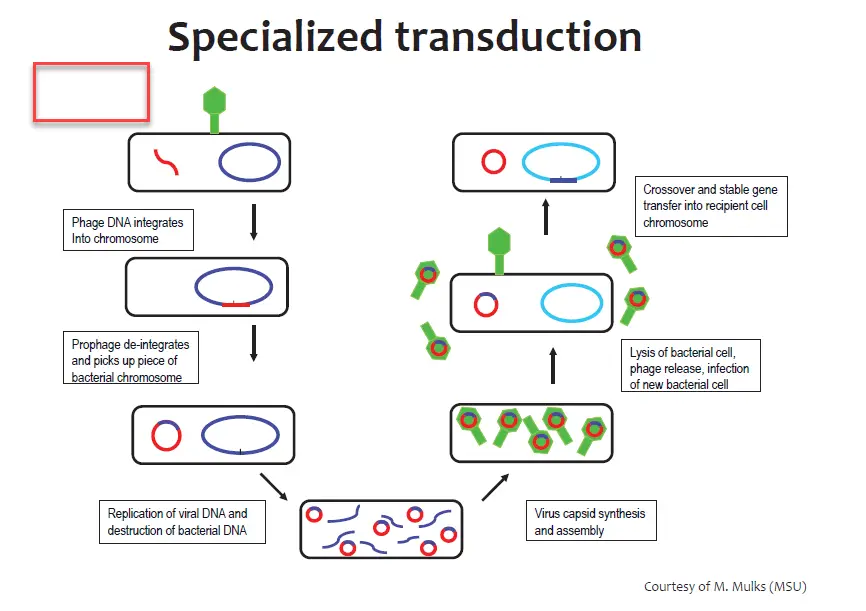
Differences between Generalized vs Specialized Transduction
Generalized and specialized transduction are both processes by which bacteriophages transfer genetic material between bacteria, but they operate through distinct mechanisms. Each process has different characteristics, impacts on bacterial populations, and applications. Here’s a breakdown of their key differences:
- Definition of Transfer
- Generalized Transduction: Transfers random parts of the bacterial DNA, without any specific targeting.
- Specialized Transduction: Transfers specific regions of the bacterial DNA, typically those adjacent to the prophage integration site.
- Type of Phage Involved
- Generalized Transduction: Mediated by virulent or lytic bacteriophages that replicate quickly, leading to cell lysis.
- Specialized Transduction: Mediated by temperate phages, which can exist in a dormant state within the host cell as a prophage.
- Lifecycle and Timing
- Generalized Transduction: Occurs during the lytic cycle of the phage, which is when the phage replicates and kills the bacterial cell.
- Specialized Transduction: Takes place during the lysogenic cycle, where the phage DNA integrates into the bacterial genome and remains dormant until it later excises to enter the lytic cycle.
- Bacterial Cell Lysis
- Generalized Transduction: Bacterial cells are rapidly lysed, releasing phages that carry random DNA fragments.
- Specialized Transduction: Bacterial cells are not immediately lysed and can survive for multiple generations, as the prophage is maintained in the bacterial genome.
- Genetic Material Packaging
- Generalized Transduction: During phage assembly, random bacterial DNA fragments are mistakenly packaged into phage capsids.
- Specialized Transduction: Specific bacterial genes, located near the prophage integration site, are packaged together with the viral DNA when the prophage excises.
- Viral DNA Integration
- Generalized Transduction: Viral DNA does not integrate into the bacterial chromosome, remaining separate from the host’s genetic material.
- Specialized Transduction: The viral DNA integrates into the bacterial chromosome as a prophage, which can later excise during the lytic cycle.
- Mechanism of Transfer
- Generalized Transduction: Occurs due to accidental packaging of bacterial DNA during phage assembly, leading to gene transfer.
- Specialized Transduction: Occurs due to imprecise excision of prophage DNA from the bacterial chromosome, which results in the transfer of adjacent bacterial genes.
- Recipient Specificity
- Generalized Transduction: Less specific in terms of gene transfer; it can occur between different bacterial strains.
- Specialized Transduction: More specific, typically transferring genes between closely related bacterial strains.
- Frequency of Transfer
- Generalized Transduction: Generally has a higher frequency of gene transfer, as it can transfer random segments of DNA.
- Specialized Transduction: Has a lower frequency due to its more precise and targeted nature.
- Applications
- Generalized Transduction: Used for gene mapping, studying genetic linkage, and transferring genes across a broad range of bacterial strains.
- Specialized Transduction: Useful for precise genetic mapping and transferring specific traits, such as antibiotic resistance genes, making it highly valuable in clinical and research contexts.
| Characteristic | Generalized Transduction | Specialized Transduction |
|---|---|---|
| Definition of Transfer | Transfers random bacterial DNA | Transfers specific bacterial DNA, typically adjacent to prophage site |
| Type of Phage Involved | Mediated by virulent (lytic) bacteriophages | Mediated by temperate phages |
| Lifecycle and Timing | Occurs during the lytic cycle | Occurs during the lysogenic cycle |
| Bacterial Cell Lysis | Bacterial cells are lysed, releasing phages with random DNA | Bacterial cells are not immediately lysed, prophage is maintained |
| Genetic Material Packaging | Random bacterial DNA is mistakenly packaged into phage capsids | Specific bacterial genes near prophage integration site are packaged |
| Viral DNA Integration | Viral DNA remains separate from bacterial chromosome | Viral DNA integrates into bacterial chromosome as a prophage |
| Mechanism of Transfer | Accidental packaging of bacterial DNA during phage assembly | Imprecise excision of prophage DNA, transferring adjacent genes |
| Recipient Specificity | Less specific; can occur between different bacterial strains | More specific; typically between closely related strains |
| Frequency of Transfer | Higher frequency, as random DNA transfer occurs | Lower frequency due to targeted nature of transfer |
| Applications | Gene mapping, genetic linkage studies, gene transfer across strains | Precise genetic mapping, transferring specific traits like resistance genes |
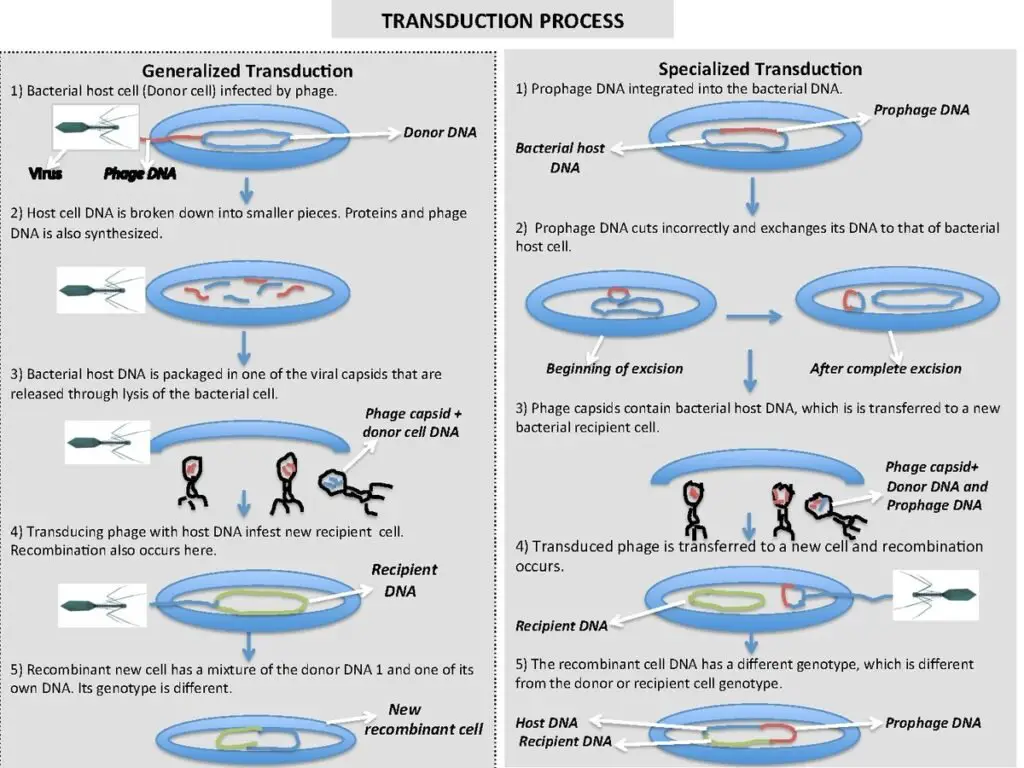
Differences between Transduction vs Transfection
Transduction | Transfection | |
|---|---|---|
| Mechanism | Mediated by bacteriophages | Mediated by artificial methods (e.g., liposomes, electroporation) |
| Genetic Material | Bacterial DNA transferred to another bacterium | Exogenous DNA (e.g., plasmid, siRNA) transferred to eukaryotic cells |
| Host Range | Bacterial cells | Eukaryotic cells |
| Methodology | Infection by bacteriophages | Introduction of exogenous DNA into cells |
| Natural Process | Yes | No |
| Delivery Efficiency | Efficient | Variable, dependent on the method used |
| Genetic Modification | Can transfer specific DNA fragments or genes | Can introduce specific genes or manipulate gene expression |
| Applications | Genetic mapping, gene transfer in bacteria | Gene expression studies, gene therapy, cell line generation, functional studies |
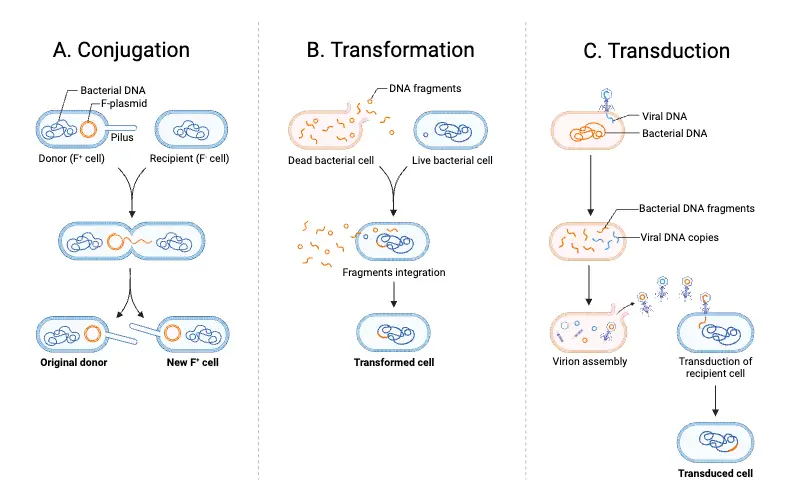
Differences between Transduction vs Transformation
Transduction | Transformation | |
|---|---|---|
| Mechanism | Mediated by bacteriophages | Uptake of exogenous DNA by recipient cells |
| Genetic Material | Bacterial DNA transferred to another bacterium | Exogenous DNA (e.g., plasmid) taken up by recipient cells |
| Methodology | Infection by bacteriophages | Uptake of DNA through physical or chemical methods |
| Natural Process | Yes | No |
| Host Range | Bacterial cells | Bacterial, yeast, plant, and animal cells |
| DNA Source | Donor bacterium | External DNA source (e.g., plasmid) |
| Genetic Modification | Can transfer specific DNA fragments or genes | Can introduce specific genes or manipulate gene expression |
| Efficiency | Can occur at low frequencies | Dependent on the recipient cell and method |
| Applications | Genetic mapping, gene transfer in bacteria | Genetic engineering, creation of transgenic organisms, gene expression studies |
Differences between Transduction vs Conjugation
| Transduction | Conjugation | |
|---|---|---|
| Mechanism | Mediated by bacteriophages | Direct cell-to-cell contact via conjugative plasmids |
| Genetic Material | Bacterial DNA transferred to another bacterium | Transfer of plasmid DNA between bacteria |
| Transfer Mechanism | DNA is packaged in bacteriophages and delivered to recipient cells | Plasmid DNA is transferred through a conjugation bridge |
| Natural Process | Yes | Yes |
| Host Range | Bacterial cells | Bacterial cells |
| DNA Source | Donor bacterium | Donor bacterium carrying conjugative plasmid |
| Type of DNA Transfer | Transfer of random DNA fragments | Transfer of entire plasmids |
| Genetic Modification | Can transfer specific DNA fragments or genes | Can transfer entire plasmids and associated genes |
| Transfer Efficiency | Less efficient compared to conjugation | Efficient in transferring plasmids between bacteria |
| Selectivity | Can transfer DNA to various bacterial strains | Can be selective for specific bacterial strains based on compatibility |
| Applications | Genetic mapping, gene transfer in bacteria | Horizontal gene transfer, spread of antibiotic resistance, genetic engineering |
Differences between Transduction vs Transmission
Transduction | Transmission | |
|---|---|---|
| Definition | Process of DNA transfer mediated by bacteriophages | Process of disease or pathogen spread from one host to another |
| Biological Context | Occurs in bacteria | Occurs in various organisms (e.g., animals, plants, humans) |
| Genetic Material | Transfer of bacterial DNA fragments | Transfer of pathogen DNA or entire infectious agents |
| Mechanism | Mediated by bacteriophages | Mediated by various modes (e.g., direct contact, respiratory droplets, vectors) |
| Transfer Route | Within bacterial populations | Between hosts or individuals |
| Host Range | Bacterial cells | Various organisms depending on the specific disease or pathogen |
| Nature | Can occur naturally or in laboratory settings | Natural occurrence in infectious diseases |
| Examples | Transduction in bacterial populations | Transmission of viruses, bacteria, parasites, etc. in infectious diseases |
| Factors Affecting | Bacterial phage-host interactions, frequency of infection | Mode of transmission, environmental factors, host susceptibility |
| Control Measures | Understanding and manipulating phage interactions in bacterial populations | Public health interventions, vaccinations, vector control, hygiene practices |
Application of Transduction
Transduction, a process where bacteriophages transfer genetic material between bacteria, has a range of applications in various fields such as genetic engineering, gene therapy, and microbiology research. Here’s how transduction is applied:
- Genetic Engineering
- Transduction is used to introduce specific genes into animal and plant cells.
- Researchers leverage this technique to modify genetic traits, developing organisms with desired characteristics.
- It plays a crucial role in agricultural biotechnology and the creation of genetically modified organisms (GMOs).
- Gene Therapy
- Transduction holds promise for treating genetic disorders by delivering therapeutic genes.
- Bacteriophages act as vectors, aiming to correct defective genes in human cells.
- This technique offers potential treatments for conditions like Duchenne muscular dystrophy.
- Antibiotic Resistance Studies
- Transduction helps understand the spread of antibiotic resistance genes among bacterial populations.
- This knowledge is essential in combating antibiotic-resistant infections, which pose significant public health challenges.
- Researchers can track how resistance genes are transferred, providing insights into strategies for managing resistant bacteria.
- Molecular Biology Research
- Transduction is a powerful tool for gene function and regulation studies.
- It allows scientists to create mutant bacterial strains with specific genetic modifications, aiding the exploration of genetic pathways and interactions.
- This process is fundamental in revealing how genes influence cellular processes.
- Comparative Genomics
- Generalized transduction is used in comparative genomics to examine genetic linkage across bacterial species.
- It helps map genes, understand evolutionary relationships, and explore genetic diversity within bacterial populations.
- Isolation of Genes
- Specialized transduction is effective in isolating genes of interest.
- By targeting specific regions of the bacterial genome, researchers can transfer desired genetic traits efficiently into recipient bacteria.
- This method is key in studies that require the precise movement of genes between bacteria.
- Phage Therapy
- Transduction also plays a role in phage therapy, where bacteriophages are used to target and eliminate pathogenic bacteria.
- Understanding how transduction works enhances the effectiveness of phage therapy.
- The process helps transfer beneficial traits among therapeutic phages, improving their ability to treat infections.
FAQ
What is bacterial transduction?
Transduction is the process by which a virus transfers genetic material from one bacterium to another. Viruses called bacteriophages are able to infect bacterial cells and use them as hosts to make more viruses.
bacterial transduction begins when a kind of virus called a —-
A bacteriophage is: a virus that infects bacteria.
How does transduction differ from other modes of genetic transfer in bacteria?
Transduction differs from other modes of genetic transfer, such as conjugation and transformation, as it involves the transfer of DNA mediated by bacteriophages.
What are the types of transduction?
There are two types of transduction: generalized transduction and specialized transduction. Generalized transduction involves the random transfer of any bacterial DNA, while specialized transduction involves the transfer of specific DNA sequences adjacent to the integrated prophage.
What is the role of bacteriophages in transduction?
Bacteriophages serve as vehicles for the transfer of bacterial DNA during transduction. They infect bacterial cells, acquire fragments of bacterial DNA, and then deliver this DNA to recipient bacteria.
How does generalized transduction occur?
In generalized transduction, during the lytic cycle of bacteriophage replication, random bacterial DNA fragments are mistakenly packaged into newly formed phage particles. These phage particles then infect other bacteria, transferring the bacterial DNA.
How does specialized transduction occur?
Specialized transduction occurs when a prophage (integrated phage genome) excises from the bacterial chromosome but carries adjacent bacterial DNA along with it. This excised prophage, now containing bacterial DNA, infects other bacteria and transfers the specific DNA sequences.
What is the significance of transduction in bacterial evolution?
Transduction plays a crucial role in bacterial evolution by facilitating the transfer of genetic material, including beneficial traits and antibiotic resistance genes, between bacterial strains or species.
Can transduction transfer specific genes or genetic markers?
Yes, transduction can transfer specific genes or genetic markers depending on the type of transduction. Specialized transduction can transfer specific DNA sequences adjacent to the integrated prophage, while generalized transduction can transfer random DNA fragments.
How is transduction different from horizontal gene transfer?
Transduction is one mechanism of horizontal gene transfer, which refers to the transfer of genetic material between organisms of the same generation. Transduction specifically involves the transfer of bacterial DNA via bacteriophages.
What are the applications of transduction in research and biotechnology?
Transduction has various applications in genetic research, including genetic mapping, gene transfer, and studying antibiotic resistance. It is also utilized in biotechnology for genetic engineering, gene therapy, and the creation of transgenic organisms.
- https://en.wikipedia.org/wiki/Transduction_(genetics)
- https://www.nature.com/scitable/definition/transduction-prokaryotes-292/
- https://www.britannica.com/science/transduction-microbiology
- https://study.com/academy/lesson/bacterial-transduction-definition-process-advantages.html
- https://www.khanacademy.org/science/ap-biology/gene-expression-and-regulation/mutations-ap/a/genetic-variation-in-prokaryotes
- https://www.slideshare.net/8988337117/vikas-pathania
- https://www.vedantu.com/biology/transduction-microbiology
- https://www.bioexplorer.net/bacterial-transduction.html/
- https://blog.addgene.org/plasmids-101-transformation-transduction-bacterial-conjugation-and-transfection
- https://byjus.com/neet/transduction-in-bacteria/
- Text Highlighting: Select any text in the post content to highlight it
- Text Annotation: Select text and add comments with annotations
- Comment Management: Edit or delete your own comments
- Highlight Management: Remove your own highlights
How to use: Simply select any text in the post content above, and you'll see annotation options. Login here or create an account to get started.